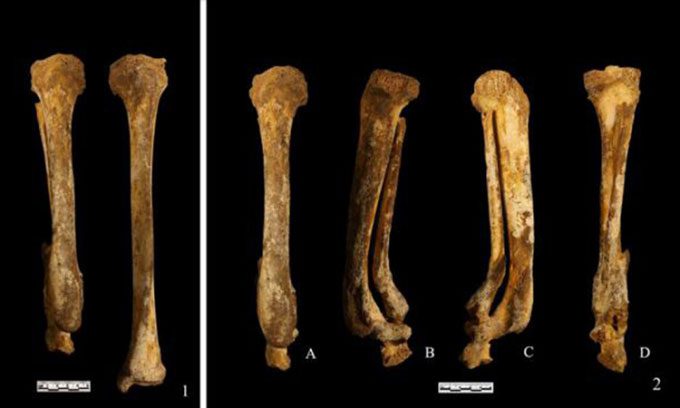A Woman Aged 30-35 Had Her Right Foot Severed as Punishment in Ancient China, Indicating She Committed a Serious Offense.
A research team at Peking University has discovered the oldest example of foot severing punishment in ancient China after analyzing the remains of a woman found in a tomb near Baoji, Shaanxi Province, SCMP reported on May 1. This area is known as the birthplace of the Zhou dynasty, often referred to as the “hometown of bronze” due to the large number of bronze vessels found, along with artifacts and tombs.

The remains of the woman were discovered in 1999, and modern technology has helped scientists determine that the foot severing was carried out as a punishment. (Photo: SCMP)
Severing one or both feet was one of the five punishments in ancient China—a harsh penal system that lasted nearly 1,000 years and ended around 200 BC. The punishments evolved over time but generally included: tattooing (mo), nose cutting (yi), foot severing (yue), castration (gong), and execution (dapi).
The remains of the woman with the severed foot were found during excavations in 1999 but were not studied in detail at the time, as archaeologists were more focused on retrieving artifacts.
Postdoctoral researcher Li Nan at Peking University stated that recent technological advancements have made it worthwhile to study these remains in detail. Li Nan is the lead author of the new study published in the journal Acta Anthropologica Sinica.
X-ray analysis revealed that the remains belonged to a woman aged 30-35 who had her right foot amputated. Individuals suffering from diseases such as diabetes, leprosy, cancer, or severe burns may have to undergo amputations.
However, an analysis of the bone density and the structure of other parts of the remains ruled out the possibility of illness. The amputation also caused severe deformities in the tibia and fibula, indicating that this was not a medical procedure.
“Based on the bioanthropological analysis of the remains and the images of victims subjected to yue punishment depicted on bronze vessels excavated from nearby tombs, it can be determined that this is an example of yue, and it is the oldest recorded case,” Li stated.
“There is an important principle in yue punishment: a minor offender would have their left foot severed, while a serious offender would have their right foot severed. It appears that the owner of the tomb in Shaanxi committed a serious crime,” Li added.
Many victims of such punishments did not survive. Survivors often lived in misery, facing ostracism and disdain from others, and struggled to make a living. Many were hired as gatekeepers for places that housed birds and animals—a subtle insult indicating they were only fit to live among beasts.
The research team found that the victim in Shaanxi did not die immediately but lived for at least five more years before dying from unknown causes. It is possible that this individual was not abandoned by their family and received better care. This case of foot severing is the first thoroughly studied instance at an archaeological site, providing valuable documentation for researching the penal system and social customs in ancient China.





















































